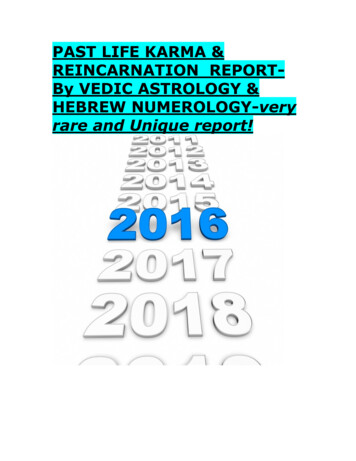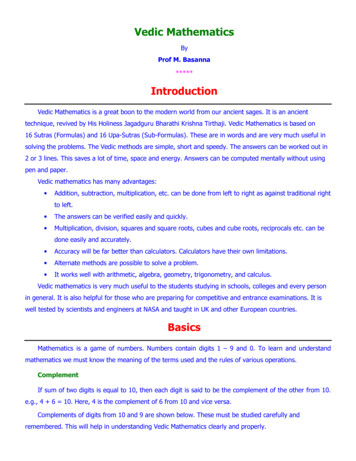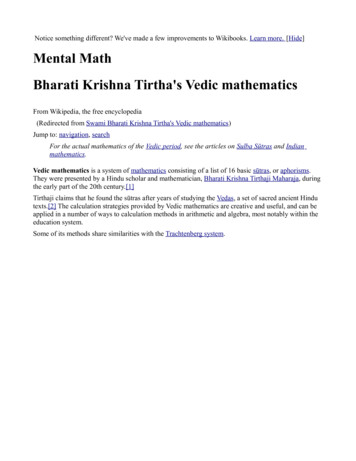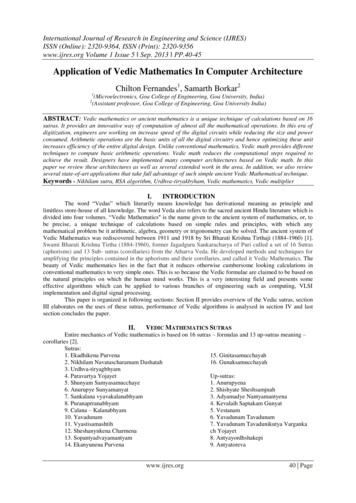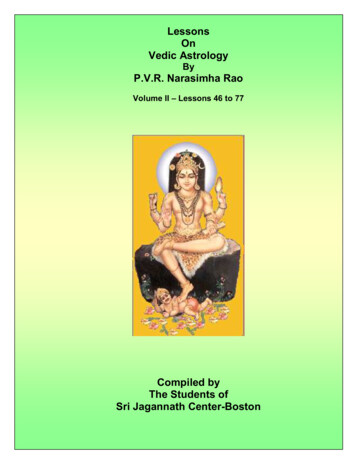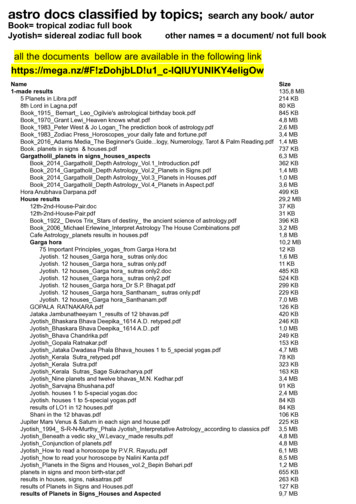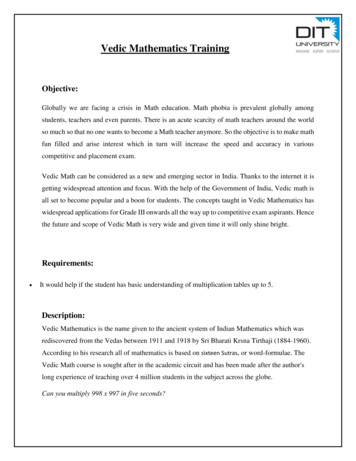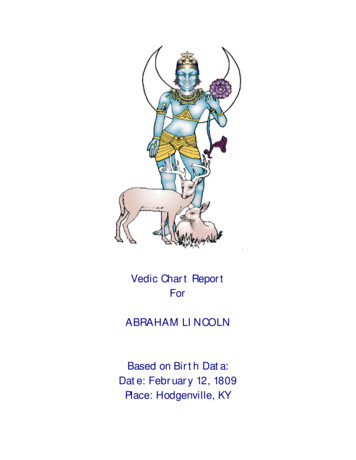
Transcription
VEDIC MATHEMATICS ‘VEDIC’ OR ‘MATHEMATICS’:A FUZZY & NEUTROSOPHICANALYSISW. B. Vasantha Kandasamye-mail: vasanthakandasamy@gmail.comweb: http://mat.iitm.ac.in/ wbvwww.vasantha.netFlorentin Smarandachee-mail: smarand@unm.eduAUTOMATONLos Angeles20061
This book can be ordered in a paper bound reprint from:Books on DemandProQuest Information & Learning(University of Microfilm International)300 N. Zeeb RoadP.O. Box 1346, Ann ArborMI 48106-1346, USATel.: 1-800-521-0600 (Customer Service)http://wwwlib.umi.com/bod/This book has been peer reviewed and recommended for publication by:Prof. Zhang Wenpeng, Department of Mathematics, Northwest University,Xi’an, Shaanxi, P.R.China.Prof. Ion Goian, Department of Algebra, Number Theory and Logic, StateUniversity of Kishinev, R. Moldova.Dr. Albena Tchamova, Bulgarian Academy of Sciences, Sofia, Bulgaria.Copyright 2006 by Automaton, W. B. Vasantha Kandasamy and FlorentinSmarandacheLegal Jurisdictions: Chennai Courts onlyCover Design and Layout by Kama KandasamyMany books can be downloaded from the followingDigital Library of Science:http://www.gallup.unm.edu/ smarandache/eBooks-otherformats.htmISBN: 1-59973-004-9Standard Address Number: 297-5092Printed in the United States of America
CONTENTSPreface5Chapter OneINTRODUCTION TO VEDIC MATHEMATICS9Chapter TwoANALYSIS OF VEDIC MATHEMATICS BYMATHEMATICIANS AND OTHERS2.1 Views of Prof. S.G.Dani about VedicMathematics from Frontline2.2 Neither Vedic Nor Mathematics2.3 Views about the Book in Favour and Against2.4 Vedas: Repositories of Ancient Indian Lore2.5 A Rational Approach to Study Ancient Literature2.6 Shanghai Rankings and Indian Universities2.7 Conclusions derived on Vedic Mathematics and theCalculations of Guru Tirthaji - Secrets ofAncient Maths3133505558596061Chapter ThreeINTRODUCTION TO BASIC CONCEPTSAND A NEW FUZZY MODEL3.1 Introduction to FCM and the Working of this Model3.2 Definition and Illustration ofFuzzy Relational Maps (FRMS)3.3 Definition of the New Fuzzy Dynamical System365657277
3.4 Neutrosophic Cognitive Maps with Examples3.5 Description of Neutrosophic Relational Maps3.6 Description of the new Fuzzy Neutrosophic model788792Chapter FourMATHEMATICAL ANALYSIS OF THEVIEWS ABOUT VEDIC MATHEMATICS USINGFUZZY MODELS4.1 Views of students about the use of VedicMathematics in their curriculum4.2 Teachers views on Vedic Mathematics andits overall influence on the Students Community4.3 Views of Parents about Vedic Mathematics4.4 Views of Educationalists about Vedic Mathematics4.5 Views of the Public about Vedic Mathematics9597101109114122Chapter FiveOBSERVATIONS5.15.25.35.45.5165Students’ ViewsViews of TeachersViews of ParentsViews of the EducatedObservations from the Views of the Public165169180182193REFERENCE197INDEX215ABOUT THE AUTHORS2204
PREFACEReligious extremism has been the root cause of most of theworld problems since time immemorial. It has decided the fatesof men and nations. In a vast nation like India, the imposition ofreligious dogma and discrimination upon the people has takenplace after the upsurge of Hindu rightwing forces in the politicalarena. As a consequence of their political ascendancy in thenorthern states of India, they started to rewrite school textbooksin an extremely biased manner that was fundamentalist andrevivalist. Not only did they meddle with subjects like history(which was their main area of operation), but they also imposedtheir religious agenda on the science subjects. There was a planto introduce Vedic Astrology in the school syllabus across thenation, which was dropped after a major hue and cry fromsecular intellectuals.This obsession with ‘Vedic’ results from the fundamentalistHindu organizations need to claim their identity as Aryan (andhence of Caucasian origin) and hence superior to the rest of thenative inhabitants of India. The ‘Vedas’ are considered ‘divine’in origin and are assumed to be direct revelations from God.The whole corpus of Vedic literature is in Sanskrit. The Vedasare four in number: Rgveda, Saamaveda, Yajurveda andAtharvaveda. In traditional Hinduism, the Vedas as a body ofknowledge were to be learnt only by the ‘upper’ caste Hindusand the ‘lower castes’ (Sudras) and so-called ‘untouchables’(who were outside the Hindu social order) were forbidden fromlearning or even hearing to their recitation. For severalcenturies, the Vedas were not written down but passed fromgeneration to generation through oral transmission. Whilereligious significance is essential for maintaining Aryansupremacy and the caste system, the claims made about theVedas were of the highest order of hyperbole. Murli ManoharJoshi, a senior Cabinet minister of the Bharatiya Janata Party(BJP) that ruled India from 1999-2004 went on to claim that acure of the dreaded AIDS was available in the Vedas! In the5
continuing trend, last week a scientist has announced thatNASA (of the USA) is using a Vedic formula to produceelectricity. One such popular topic of Hindutva imposition wasVedic Mathematics. Much of the hype about this topic is basedon one single book authored by the Sankaracharya (the highestHindu pontiff) Jagadguru Swami Sri Bharati Krsna TirthajiMaharaja titled Vedic Mathematics and published in the year1965, and reprinted several times since the 1990s [51]. Thisbook was used as the foundation and the subject wassystematically introduced in schools across India. It wasintroduced in the official curriculum in the school syllabus inthe states of Uttar Pradesh and Madhya Pradesh. Further,schools run by Hindutva sympathizers or trusts introduced itinto their curriculum. In this juncture, the first author of thisbook started working on this topic five years back, and has sincemet over 1000 persons from various walks of life and collectedtheir opinion on Vedic Mathematics. This book is the result ofthose interactions.In this book the authors probe into Vedic Mathematics (aconcept that gained renown in the period of the religious fanaticand revivalist Hindutva rule in India): and explore whether it isreally ‘Vedic’ in origin or ‘Mathematics’ in content. The entirefield of Vedic Mathematics is supposedly based on 16 one-tothree-word sutras (aphorisms) in Sanskrit, which they claim cansolve all modern mathematical problems. However, a carefulperusal of the General Editor’s note in this book gives away thebasic fact that the origin of these sutras are not ‘Vedic’ at all.The book’s General Editor, V.S. Agrawala, (M.A., PhD.D.Litt.,) writes in page VI as follows:“It is the whole essence of his assessment of Vedictradition that it is not to be approached from a factualstandpoint but from the ideal standpoint viz., as theVedas, as traditionally accepted in India as the repositoryof all knowledge, should be and not what they are inhuman possession. That approach entirely turns the tableon all critics, for the authorship of Vedic mathematicsneed not be labouriously searched for in the texts aspreserved from antiquity. [ ]6
In the light of the above definition and approachmust be understood the author’s statement that thesixteen sutras on which the present volume is based frompart of a Parisista of the Atharvaveda. We are aware thateach Veda has its subsidiary apocryphal text some ofwhich remain in manuscripts and others have beenprinted but that formulation has not closed. For example,some Parisista of the Atharvaveda were edited byG.M.Bolling and J. Von Negelein, Leipzig,1909-10. Butthis work of Sri Sankaracharyaji deserves to be regardedas a new Parisista by itself and it is not surprising thatthe Sutras mentioned herein do not appear in the hithertoknown Parisistas.A list of these main 16 Sutras and of their sub-sutrasor corollaries is prefixed in the beginning of the text andthe style of language also points to their discovery by SriSwamiji himself. At any rate, it is needless to dwelllonger on this point of origin since the vast merit ofthese rules should be a matter of discovery for eachintelligent reader. Whatever is written here by the authorstands on its own merits and is presented as such to themathematical world. [emphasis supplied]”The argument that Vedas means all knowledge and hencethe fallacy of claiming even 20th century inventions to belong tothe Vedas clearly reveals that there is a hidden agenda inbestowing such an antiquity upon a subject of such a recentorigin. There is an open admission that these sutras are theproduct of one man’s imagination. Now it has become clear tous that the so-called Vedic Mathematics is not even Vedic inorigin.Next, we wanted to analyze the mathematical content andits ulterior motives using fuzzy analysis. We analyzed thisproblem using fuzzy models like Fuzzy Cognitive Maps (FCM),Fuzzy Relational Maps (FRM) and the newly constructed fuzzydynamical system (and its Neutrosophic analogue) that cananalyze multi-experts opinion at a time using a single model.The issue of Vedic Mathematics involves religious politics,caste supremacy, apart from elementary arithmetic—so we7
cannot use simple statistics for our analysis. Further any study,when scientifically carried out using fuzzy models has morevalue than a statistical approach to the same. We used linguisticquestionnaires for our data collection; experts filled in thesequestionnaires. In many cases, we also recorded our interviewswith the experts in case they did not possess the technicalknowledge of working with our questionnaire. Apart from this,several group discussions and meetings with various groups ofpeople were held to construct the fuzzy models used to analyzethis problem.This book has five chapters. In Chapter I, we give a briefdescription of the sixteen sutras invented by the Swamiji.Chapter II gives the text of select articles about VedicMathematics that appeared in the media. Chapter III recallssome basic notions of some Fuzzy and Neutrosophic modelsused in this book. This chapter also introduces a fuzzy model tostudy the problem when we have to handle the opinion of multiexperts. Chapter IV analyses the problem using these models.The final chapter gives the observations made from our study.The authors thank everybody who gave their opinion aboutVedic Mathematics. Without their cooperation, the book couldnot have materialized. We next thank Dr.K.Kandasamy forproof-reading the book. I thank Meena and Kama for the layoutand formatting of this book. Our thanks are also due to Prof.Praveen Prakash, Prof. Subrahmaniyam, Prof. E. L.Piriyakumar, Mr. Gajendran, Mr. S. Karuppasamy, Mr.Jayabhaskaran, Mr. Senguttuvan, Mr. Tamilselvan, Mr. D.Maariappan, Mr. P. Ganesan, Mr. N. Rajkumar and Ms.Rosalyn for the help rendered in various ways that couldconvert this book into a solid reality. We also thank the studentsof All India Students Federation (AISF) and the StudentsFederation of India (SFI) for their help in my work.The authors dedicate this book to the great philosopher andintellectual Rahul Sangridyayan who revealed and exposed tothe world many of the truths about the Vedas.We have given a long list of references to help theinterested reader.W.B.VASANTHA KANDASAMYFLORENTIN SMARANDACHE8
Chapter OneINTRODUCTION TOVEDIC MATHEMATICSIn this chapter we just recall some notions given in the book onVedic Mathematics written by Jagadguru Swami Sri BharatiKrsna Tirthaji Maharaja (Sankaracharya of Govardhana Matha,Puri, Orissa, India), General Editor, Dr. V.S. Agrawala. Beforewe proceed to discuss the Vedic Mathematics that he professedwe give a brief sketch of his heritage [51].He was born in March 1884 to highly learned and piousparents. His father Sri P Narasimha Shastri was in service as aTahsildar at Tinnivelly (Madras Presidency) and later retired asa Deputy Collector. His uncle, Sri Chandrasekhar Shastri wasthe principal of the Maharajas College, Vizianagaram and hisgreat grandfather was Justice C. Ranganath Shastri of theMadras High Court. Born Venkatraman he grew up to be abrilliant student and invariably won the first place in all thesubjects in all classes throughout his educational career. Duringhis school days, he was a student of National CollegeTrichanapalli; Church Missionary Society College, Tinnivelliand Hindu College Tinnivelly in Tamil Nadu. He passed hismatriculation examination from the Madras University in 1899topping the list as usual. His extraordinary proficiency inSanskrit earned him the title “Saraswati” from the MadrasSanskrit Association in July 1899. After winning the highestplace in the B.A examination Sri Venkataraman appeared for9
the M.A. examination of the American College of Sciences,Rochester, New York from the Bombay center in 1903. Hissubject of examination was Sanskrit, Philosophy, English,Mathematics, History and Science. He had a superb retentivememory.In 1911 he could not anymore resist his burning desire forspiritual knowledge, practice and attainment and therefore,tearing himself off suddenly from the work of teaching, he wentback to Sri Satcidananda Sivabhinava Nrisimha Bharati Swamiat Sringeri. He spent the next eight years in the profoundeststudy of the most advanced Vedanta Philosophy and practice ofthe Brahmasadhana.After several years in 1921 he was installed on thepontifical throne of Sharada Peetha Sankaracharya and later in1925 he became the pontifical head of Sri Govardhan Math Puriwhere he served the remainder of his life spreading the holyspiritual teachings of Sanatana Dharma.In 1957, when he decided finally to undertake a tour of theUSA he rewrote from his memory the present volume of VedicMathematics [51] giving an introductory account of the sixteenformulae reconstructed by him. This is the only work onmathematics that has been left behind by him.Now we proceed on to give the 16 sutras (aphorisms orformulae) and their corollaries [51]. As claimed by the editor,the list of these main 16 sutras and of their sub-sutras orcorollaries is prefixed in the beginning of the text and the styleof language also points to their discovery by Sri Swamijihimself. This is an open acknowledgement that they are notfrom the Vedas. Further the editor feels that at any rate it isneedless to dwell longer on this point of origin since the vastmerit of these rules should be a matter of discovery for eachintelligent reader.Now having known that even the 16 sutras are theJagadguru Sankaracharya’s invention we mention the name ofthe sutras and the sub sutras or corollaries as given in the book[51] pp. XVII to XVIII.10
Sixteen Sutras and their corollariesSl.SutrasNo1. Ekādhikena Pūrvena(also a corollary)2. NikhilamNavataścaramam Daśatah3. Ūrdhva - tiryagbhyām4. Parāvartya Yojayet5. SūnyamSamyasamuccaye6. (Ānurūpye) Śūnyamanyat7. Sankalana vyavakalanābhyām8. Puranāpuranābhyām9. Calanā kalanābhyām10. Yāvadūnam11. Vyastisamastih12. Śesānyankena Caramena13.Sopantyadvayamantyam14.15.16.Sub sutras or CorollariesĀnurūpyenaŚisyate ŚesamjnahĀdyamādyenantyamantyenaKevalaih Saptakam GunỹatVestanamYāvadūnam TāvadūnamYāvadūnam TāvadūnīkrtyaVargaňca YojayetAntyayordasake’ na PūrvenaGunitasamuccayahGunakasamuccayahThe editor further adds that the list of 16 slokas has beencomplied from stray references in the text. Now we givespectacular illustrations and a brief descriptions of the sutras.The First Sutra: Ekādhikena PūrvenaThe relevant Sutra reads Ekādhikena Pūrvena which renderedinto English simply says “By one more than the previous one”.Its application and “modus operandi” are as follows.(1) The last digit of the denominator in this case being 1 and theprevious one being 1 “one more than the previous one”11
evidently means 2. Further the proposition ‘by’ (in the sutra)indicates that the arithmetical operation prescribed is eithermultiplication or division. We illustrate this example from pp. 1to 3. [51]Let us first deal with the case of a fraction say 1/19. 1/19where denominator ends in 9.By the Vedic one - line mental method.A. First method.0 5 2 6 31 5 7 8 9 4 7 3 6 8 4 2 i1 19 1 1 111 1 1 11B. Second Method.0 5 2 6 3 1 5 7 8 / 9 4 7 3 6 8 4 2 i1 11 1 11 1 119 1 1This is the whole working. And the modus operandi isexplained below.A. First MethodModus operandi chart is as follows:(i) We put down 1 as the right-hand most digit(ii) We multiply that last digit 1 by 2 and put the 2down as the immediately preceding digit.(iii) We multiply that 2 by 2 and put 4 down as thenext previous digit.(iv) We multiply that 4 by 2 and put it down thus(v) We multiply that 8 by 2 and get 16 as theproduct. But this has two digits. We thereforeput the product. But this has two digits wetherefore put the 6 down immediately to theleft of the 8 and keep the 1 on hand to becarried over to the left at the next step (as we121214218421
always do in all multiplication e.g. of 69 2 138 and so on).(vi) We now multiply 6 by 2 get 12 as product, addthereto the 1 (kept to be carried over from theright at the last step), get 13 as theconsolidated product, put the 3 down and keepthe 1 on hand for carrying over to the left atthe next step.6842113684211 1(vii) We then multiply 3 by 2 add the one carriedover from the right one, get 7 as theconsolidated product. But as this is a singledigit number with nothing to carry over tothe left, we put it down as our nextmultiplicand.73684211 1((viii) and xviii) we follow this procedurecontinually until we reach the 18th digitcounting leftwards from the right, when wefind that the whole decimal has begun torepeat itself. We therefore put up the usualrecurring marks (dots) on the first and the lastdigit of the answer (from betokening that thewhole of it is a Recurring Decimal) and stopthe multiplication there.Our chart now reads as follows:119 .052631578/94736842i.111111/111B. Second MethodThe second method is the method of division (instead ofmultiplication) by the self-same “Ekādhikena Pūrvena” namely2. And as division is the exact opposite of multiplication it13
stands to reason that the operation of division should proceednot from right to left (as in the case of multiplication asexpounded here in before) but in the exactly opposite direction;i.e. from left to right. And such is actually found to be the case.Its application and modus operandi are as follows:(i) Dividing 1 (The first digit of the dividend) by2, we see the quotient is zero and theremainder is 1. We therefore set 0 down as thefirst digit of the quotient and prefix theremainder 1 to that very digit of the quotient(as a sort of reverse-procedure to the carryingto the left process used in multiplication) andthus obtain 10 as our next dividend.(ii) Dividing this 10 by 2, we get 5 as the seconddigit of the quotient, and as there is noremainder to be prefixed thereto we take upthat digit 5 itself as our next dividend.01.051(iii) So, the next quotient – digit is 2, and theremainder is 1. We therefore put 2 down as thethird digit of the quotient and prefix theremainder 1 to that quotient digit 2 and thushave 12 as our next dividend.0521 1(iv) This gives us 6 as quotient digit and zero asremainder. So we set 6 down as the fourthdigit of the quotient, and as there is noremainder to be prefixed thereto we take 6itself as our next digit for division which givesthe next quotient digit as 3.0526311 11(v) That gives us 1 and 1 as quotient andremainder respectively. We therefore put 1down as the 6th quotient digit prefix the 1thereto and have 11 as our next dividend.05263151 11114
(vi to xvii) Carrying this process of straight continuousdivision by 2 we get 2 as the 17th quotient digit and 0 asremainder.(xviii) Dividing this 2 by 2 are get 1 as 18thquotient digit and 0 as remainder. But this is . 0 5 2 6 3 1 5 7 8exactly what we began with. This means that 1 11111the decimal begins to repeat itself from here. 9 4 7 3 6 8 4 2 iSo we stop the mental division process and1 11put down the usual recurring symbols (dots)stthon the 1 and 18 digit to show that thewhole of it is a circulating decimal.Now if we are interested to find 1/29 the student shouldnote down that the last digit of the denominator is 9, but thepenultimate one is 2 and one more than that means 3. Likewisefor 1/49 the last digit of the denominator is 9 but penultimate is4 and one more than that is 5 so for each number theobservation must be memorized by the student and remembered.The following are to be noted1. Student should find out the procedure to be followed.The technique must be memorized. They feel it isdifficult and cumbersome and wastes their time andrepels them from mathematics.2. “This problem can be solved by a calculator in a timeless than a second. Who in this modernized world takeso much strain to work and waste time over such simplecalculation?” asked several of the students.3. According to many students the long division methodwas itself more interesting.The Second Sutra: Nikhilam Navataścaramam DaśatahNow we proceed on to the next sutra “Nikhilam sutra” The sutrareads “Nikhilam Navataścaramam Daśatah”, which literallytranslated means: all from 9 and the last from 10”. We shall15
presently give the detailed explanation presently of the meaningand applications of this cryptical-sounding formula [51] andthen give details about the three corollaries.He has given a very simple multiplication.Suppose we have to multiply 9 by 7.1. We should take, as base for our calculationsthat power of 10 which is nearest to thenumbers to be multiplied. In this case 10 itselfis that power.2.3.4.5.ororor(10)9–17–36/ 3Put the numbers 9 and 7 above and below on the left handside (as shown in the working alongside here on the righthand side margin);Subtract each of them from the base (10) and write down theremainders (1 and 3) on the right hand side with aconnecting minus sign (–) between them, to show that thenumbers to be multiplied are both of them less than 10.The product will have two parts, one on the left side and oneon the right. A vertical dividing line may be drawn for thepurpose of demarcation of the two parts.Now, the left hand side digit can be arrived at in one of the 4waysa) Subtract the base 10 from the sum of thegiven numbers (9 and 7 i.e. 16). And put(16 – 10) i.e. 6 as the left hand part of theanswer9 7 – 10 6b) Subtract the sum of two deficiencies (1 3 4) from the base (10) you get the sameanswer (6) again10 – 1 – 3 6c) Cross subtract deficiency 3 on the secondrow from the original number 9 in the firstrow. And you find that you have got (9 –3) i.e. 6 again9–3 6d) Cross subtract in the converse way (i.e. 1from 7), and you get 6 again as the lefthand side portion of the required answer7 – 1 6.16
Note: This availability of the same result in several easy ways isa very common feature of the Vedic system and is greatadvantage and help to the student as it enables him to test andverify the correctness of his answer step by step.6. Now vertically multiply the two deficit figures (1 and 3).The product is 3. And this is the right hand side portionof the answer(10) 9 – 17–37. Thus 9 7 63.6/3This method holds good in all cases and is therefore capableof infinite application. Now we proceed on to give theinterpretation and working of the ‘Nikhilam’ sutra and its threecorollaries.The First CorollaryThe first corollary naturally arising out of the Nikhilam Sutrareads in English “whatever the extent of its deficiency lessen itstill further to that very extent, and also set up the square of thatdeficiency”.This evidently deals with the squaring of the numbers. A fewelementary examples will suffice to make its meaning andapplication clear:Suppose one wants to square 9, the following are thesuccessive stages in our mental working.(i) We would take up the nearest power of 10, i.e. 10 itself asour base.(ii) As 9 is 1 less than 10 we should decrease it still further by 1and set 8 down as our left side portion of the answer8/(iii) And on the right hand we put down the square8/1.of that deficiency 129–1(iv) Thus 92 819–18/117
Now we proceed on to give second corollary from (p.27, [51]).The Second CorollaryThe second corollary in applicable only to a special case underthe first corollary i.e. the squaring of numbers ending in 5 andother cognate numbers. Its wording is exactly the same as thatof the sutra which we used at the outset for the conversion of‘vulgar’ fractions into their recurring decimal equivalents. Thesutra now takes a totally different meaning and in fact relates toa wholly different setup and context.Its literal meaning is the same as before (i.e. by one morethan the previous one”) but it now relates to the squaring ofnumbers ending in 5. For example we want to multiply 15. Herethe last digit is 5 and the “previous” one is 1. So one more thanthat is 2.Now sutra in this context tells us to multiply the previousdigit by one more than itself i.e. by 2. So the left hand side digitis 1 2 and the right hand side is the vertical multiplicationproduct i.e. 25 as usual.1 /52 / 25Thus 152 1 2 / 25 2 / 25.Now we proceed on to give the third corollary.The Third CorollaryThen comes the third corollary to the Nikhilam sutra whichrelates to a very special type of multiplication and which is notfrequently in requisition elsewhere but is often required inmathematical astronomy etc. It relates to and provides formultiplications where the multiplier digits consists entirely ofnines.The procedure applicable in this case is therefore evidentlyas follows:i)Divide the multiplicand off by a vertical line into a righthand portion consisting of as many digits as the multiplier;18
and subtract from the multiplicand one more than the wholeexcess portion on the left. This gives us the left hand sideportion of the product;or take the Ekanyuna and subtract therefrom the previous i.e.the excess portion on the left; andii) Subtract the right hand side part of the multiplicand by theNikhilam rule. This will give you the right hand side of theproduct.The following example will make it clear:43 94 : 3 ::–5 : 33 : 8 :7The Third Sutra: Ūrdhva TiryagbhyāmŪrdhva Tiryagbhyām sutra which is the General Formulaapplicable to all cases of multiplication and will also be foundvery useful later on in the division of a large number by anotherlarge number.The formula itself is very short and terse, consisting of only onecompound word and means “vertically and cross-wise.” Theapplications of this brief and terse sutra are manifold.A simple example will suffice to clarify the modus operandithereof. Suppose we have to multiply 12 by 13.(i) We multiply the left hand most digit 1 of the 12multiplicand vertically by the left hand most 13.digit 1 of the multiplier get their product 1 1:3 2:6 156and set down as the left hand most part ofthe answer;(ii) We then multiply 1 and 3 and 1 and 2 crosswise add the twoget 5 as the sum and set it down as the middle part of theanswer; and19
(iii) We multiply 2 and 3 vertically get 6 as their product and putit down as the last the right hand most part of the answer.Thus 12 13 156.The Fourth Sutra: Parāvartya YojayetThe term Parāvartya Yojayet which means “Transpose andApply.” Here he claims that the Vedic system gave a number isapplications one of which is discussed here. The veryacceptance of the existence of polynomials and the consequentremainder theorem during the Vedic times is a big question sowe don’t wish to give this application to those polynomials.However the four steps given by them in the polynomialdivision are given below: Divide x3 7x2 6x 5 by x – 2.i.ii.iii.iv.x3 divided by x gives us x2 which is therefore the first termof the quotientx 3 7x 2 6x 5 Q x2 .x 2x2 –2 –2x2 but we have 7x2 in the divident. This meansthat we have to get 9x2 more. This must result from themultiplication of x by 9x. Hence the 2nd term of the divisormust be 9xx 3 7x 2 6x 5 Q x2 9x .x 2As for the third term we already have –2 9x –18x. Butwe have 6x in the dividend. We must therefore get anadditional 24x. Thus can only come in by the multiplicationof x by 24. This is the third term of the quotient. Q x2 9x 24Now the last term of the quotient multiplied by – 2 gives us– 48. But the absolute term in the dividend is 5. We havetherefore to get an additional 53 from some where. Butthere is no further term left in the dividend. This means thatthe 53 will remain as the remainder Q x2 9x 24 andR 53.20
This method for a general degree is not given. However thisdoes not involve anything new. Further is it even possible thatthe concept of polynomials existed during the period of Vedasitself?Now we give the 5th sutra.The Fifth Sutra: Sūnyam SamyasamuccayeWe begin this section with an exposition of several special typesof equations which can be practically solved at sight with theaid of a beautiful special sutra which reads SūnyamSamyasamuccaye and which in cryptic language which rendersits applicable to a large number of different cases. It merely says“when the Samuccaya is the same that Samuccaya is zero i.e. itshould be equated to zero.”Samuccaya is a technical term which has several meaningsin different contexts which we shall explain one at a time.Samuccaya firstly means a term which occurs as a commonfactor in all the terms concerned.Samuccaya secondly means the product of independentterms.Samuccaya thirdly means the sum of the denominators oftwo fractions having same numerical numerator.Fourthly Samuccaya means combination or total.Fifth meaning: With the same meaning i.e. total of the word(Samuccaya) there is a fifth kind of application possible withquadratic equations.Sixth meaning – With the same sense (total of the word –Samuccaya) but in a different application it comes in handy tosolve harder equations equated to zero.Thus one has to imagine how the six shades of meaningshave been perceived by the Jagadguru Sankaracharya that toofrom the Vedas when such types of equations had not even beeninvented in the world at that point of tim
INTRODUCTION TO VEDIC MATHEMATICS 9 Chapter Two ANALYSIS OF VEDIC MATHEMATICS BY MATHEMATICIANS AND OTHERS 31 2.1 Views of Prof. S.G.Dani about Vedic Mathematics from Frontline 33 2.2 Neither Vedic Nor Mathematics 50 2.3 Views about the Book in Favour and Aga

